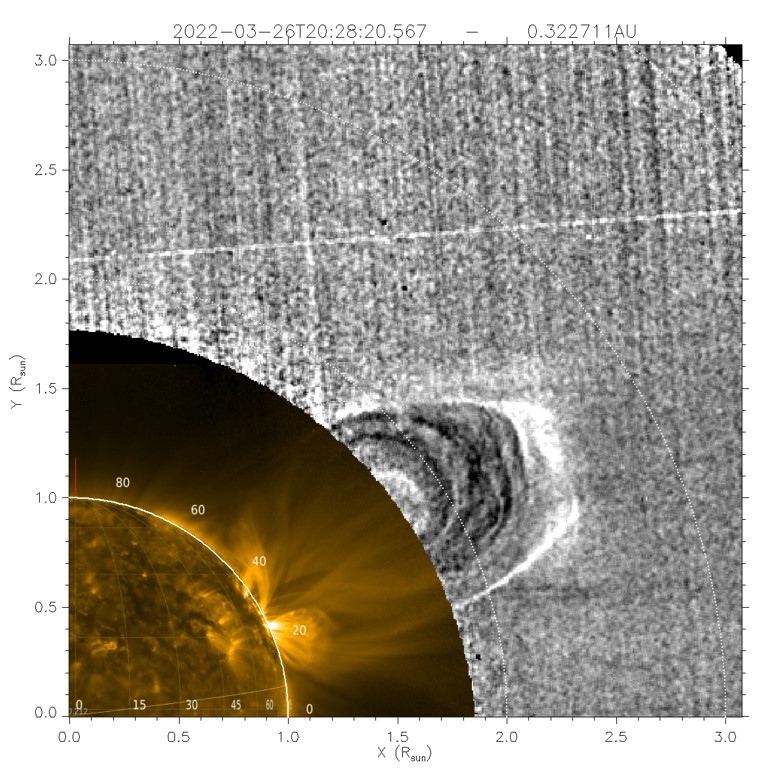
Alessandro Bemporad – INAF Osservatorio Astrofisico di Torino
The Sun, our star, is currently in the maximum phase of its eleven-year activity cycle. This means that not only is the solar disk marked by numerous sunspots, but also that the active regions associated with these spots (which are concentrations of very intense magnetic fields) are the source of numerous solar eruptions. Some of these eruptions occasionally impact Earth, interacting with the protective magnetic shield known as the magnetosphere, and generating spectacular auroras, which, on rare occasions, are visible even at our latitudes.
As has long been known, solar eruptions—particularly the so-called Coronal Mass Ejections (CMEs)—often carry magnetic fields with a peculiar helical configuration. It is precisely the interaction between this helical magnetic field and Earth’s magnetospheric field that is often responsible for geomagnetic storms on Earth. This magnetic helix is also what enables the formation of solar prominences above the solar surface; these prominences can sometimes lose their equilibrium, triggering an eruptive prominence and thus a solar eruption.
However, the origin of this helical magnetic field configuration is still under debate. In many eruptions, data analysis shows that this magnetic helix forms several days before the eruption, in what is referred to as the magnetic field’s “flux rope.” In such cases, theoretical models predict that it is the accumulation of magnetic twist within the helix that leads to its destabilization: once a critical threshold is exceeded—like a wound-up spring being released—the twist can no longer be retained, and the magnetic helix is expelled. These models also typically predict that during the eruption, the stored twist is released, resulting in a progressive untwisting of the magnetic field lines as the eruption propagates. This untwisting is associated with a magnetic writhe—a torsion of the eruption around its direction of propagation—which may give rise to helical motions within the eruption. These motions have, in fact, been observed in many instances using a variety of techniques. The process is expected to conserve a key quantity known as magnetic helicity, which measures the overall “tangledness” of the magnetic field, converting the pre-eruption twist into writhe during the eruption.
In other cases, however, it appears clear that the magnetic configuration does not exist prior to the eruption, but rather forms during the eruption itself, via a fundamental process almost always associated with solar eruptions called magnetic reconnection. This mechanism essentially allows the conversion of energy stored in the pre-eruption magnetic field configuration into other forms of energy (kinetic, thermal, etc.), while conserving the system’s total energy. In such scenarios, the formation of a magnetic helix through magnetic reconnection during the eruption should not lead to the development of helical motions—or at least, such motions have never been observed or predicted by any models of this kind of eruption.
Recently, however, high-cadence observations from the Metis coronagraph onboard the ESA Solar Orbiter mission have revealed precisely such motions within a solar eruption that lacked a pre-existing helical magnetic field configuration. This discovery was reported in a recently published article (Bemporad et al., 2025) and was made possible thanks to the observations taken by the Metis coronagraph aboard ESA’s Solar Orbiter. Before this mission, no solar eruption had ever been observed with coronagraphic images at a cadence of just 20 seconds per frame. In fact, these motions occur at unexpectedly higher speeds than the propagation of the eruption itself, and could not have been observed with instruments operating at lower cadence. It is only due to this high cadence, combined with the close-up view offered by the ESA Solar Orbiter (which was only 0.32 AU from the Sun at the time), that this phenomenon could be observed for the very first time.
The theoretical interpretation of this discovery also relied on observations from two other instruments aboard the Solar Orbiter: the EUI/FSI telescope and the PHI/FDT magnetometer, highlighting the importance of synergy between the various onboard instruments. A possible explanation for the origin of these motions was proposed in Bemporad et al. (2025), based on the idea that—as predicted by some more recent models—in eruptions where the magnetic helix forms during the eruption itself, the opposite phenomenon may occur compared to eruptions involving a pre-existing helix. That is, initial writhe (magnetic torsion) may be converted into twist of the helix—again while conserving the total magnetic helicity—leading to the formation of the observed helical motions. However, a deeper theoretical understanding will be necessary to confirm the proposed interpretation.
Certainly, future theoretical models of solar eruptions not involving a pre-existing magnetic helix will need to be revised to account for and explain the plasma motions reported in this study. The inclusion of such small-scale phenomena will make the models more realistic, ultimately enhancing our understanding of the origin of solar eruptions—and, consequently, improving our ability to predict these events in the future.
For further information see the original article:
“Discovery of Small Scale Flows in the Void of a Coronal Mass Ejection with High-cadence Images Acquired by the Metis Coronagraph On-board Solar Orbiter“, Bemporad et al. 2025, The Astrophysical Journal (in press).
DOI: 10.3847/1538-4357/adc7ff
Very high-speed sequence of images acquired by the Metis coronagraph demonstrating the presence of clockwise helical motions within the solar eruption.

